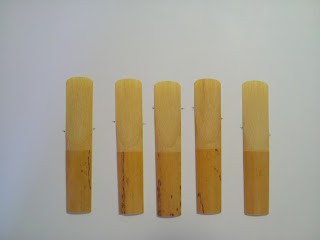I’ve read over and over again that natural reeds are failing in quality and are inconsistent within a box let alone between boxes. To test this I purchased some Hemke #4 reeds to use on my Yamaha 5C mouthpiece. This piece is my go to piece for classical practice and chamber work. I really like how dark the tone gets as well as how locked in the intonation is when pared with my YBS-61.
On first examination I found that the heel of each reed is not symmetrical. The left and right sides of the heel end have a wide amount of variability. If you look closely you can see that the individual heels are different thicknesses. This could be due to the reed blank shifting or not secured as tightly as it should have been on the planing machine Effect on the reed?
My second point of consideration is the file mark and the shoulder. As seen below the file marks are all straight and are the same height. The shoulders are quite the telling characteristic. The shoulders are not cut evenly. The desired rounded “V” or “U” shape made by reed profiler is not centered an any reed but the center one. Some reeds are cut slightly left or right of the center line.
The offset shoulder cut directly effects the shape of the vamp; the area from the file mark to the reed tip. i marked in the image below the point at which the reeds shoulder cut ends at the rails. Ideally this would be even left to right on each reed even if not even between reeds. As you can see below, the rails begin in very different areas on the same reed. Will this effect playability?
The next thing I examine is the heart’s shape. Does it have that familiar chevron shape? Unfortunately I was unable to take pictures that would show the heart shapes but the reeds with the best defined heart which terminated before the end of the reed was reed 3 and 5. This I know will effect playability.
Lastly I inspect the reeds tip for warping, splits, or any other damage. Unfortunately I did not have my calipers available to measure the tips for comparison.All reeds had well formed tips with no raggedness or obvious imperfections.



